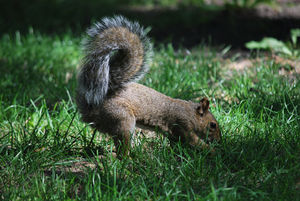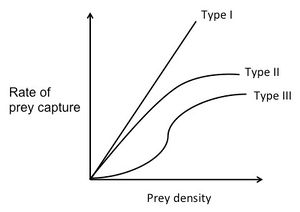Foraging

Many animals forage in the soil and other locations, looking for food such as plants or smaller organisms. The optimal foraging theory and optimal diet model are used to predict the decisions animals will make while foraging. Both microorganisms and macroorganisms can forage.
Different Types of Foragers
The optimal foraging theory is widely applicable to animals living different lifestyles with different feeding strategies. There are certain categories that animals fall into that have their own unique foraging/predation strategies. They are as follows:
- True Predators: These attack large numbers of prey throughout their life, as it is their main source of food. They kill and eat their prey immediately or shortly after the attack, and may eat it all, abandon part of their prey after they are fulfilled, leaving the rest behind. Some examples are lions, tigers, sharks, ants, seed-eating birds, etc.
- Grazers: These eat only a proportion of their prey. They might harm the prey, but they typically do not kill it. Some examples include cattle, antelope, mosquitoes, etc.
- Parasites: Similar to grazers, parasites only eat a portion of their prey and do not typically kill it. They spend all, or a large portion of their life span feeding off of a specific host. Some examples include tapeworms, liver flukes, plant parasites, etc.
- Parasitoids: This is a relationship where eggs are laid inside of another organism, and when they hatch they consume the host from the inside, killing it in the process. This relationship is common for wasps and some species of flies. It is also a relationship between some viruses that attack single-celled organisms, reproducing inside and eventually killing their host. [9]
Optimal Foraging Theory
The optimal foraging theory predicts how an animal foraging will behave when presented with a choice in prey. This theory takes into account the energy the organism receives from the prey, and also the energy and time it costs to forage for the prey. Animals want to receive the greatest benefit of energy while expending the least amount of their own time and energy. The goal of this theory is to find the foraging strategy that maximizes the energy the species receives under the constraints of its environment. These constraints include how long it takes for the animal to travel to the foraging sites, how long it takes to search for the prey, how long it takes for the animal to prepare its foraged prey for eating, along with other factors. The optimal diet model can be used to find the optimal foraging strategy.
Optimal Diet Model

In this model, predators have to decide whether to eat the prey they find or look for another more profitable source of prey. Animals have to choose between small prey and large prey. They do this by considering the search time, handling time (how long it takes to prepare the prey for eating), and energy they would gain. To determine the profitability in this model, the value of energy the animal will receive should be divided by the handling time. The prey with the higher value is more profitable. However, if the predator comes across one prey and has to decide whether to eat it or look for another source of prey, search time for that second prey has to be taken into consideration. If the energy value divided by the handling time plus the search time of the second prey is greater than the energy value divided by the handling time of the first prey, then the animal should search for the second prey.
As shown in the following equation, the animal should only search for the second source of prey if E2/(h2+S2) > E1/h1. In this equation, E1 and E2 are the energy values benefited from prey 1 and prey 2, respectively, in calories. h1 and h2 are the handling time of prey 1 and prey 2, and S2 is the search time for prey 2. If S2 is in a certain value threshold, the animal will eat both prey. These animals that eat both prey are often considered generalists, while animals that do not are considered specialists. It should also be noted that the animal searching for prey will not be consciously doing this equation or thinking of the benefits or lack of for certain prey. This equation/model quantifies natural unconscious behavior.
The search time depends on the density of prey. Functional response curves are used to plot the rate of prey capture over the prey density. There are type 1, type 2, and type 3 response curves.
In type 1, there is a linear relationship between the rate of prey captured and prey density. As the rate of prey capture increases, so does prey density. If prey density is low, then search time is high. When a forager finally finds food, it will eat whatever prey it finds. As prey densities increase, it becomes easier and easier to find food, and search time decreases. Eventually, it may become so high that the forager may choose to not eat a certain type of food it finds. It will choose the food to eat that has the largest E/h value. [9]
In type 2 response curves, the rate of prey captured increases with prey density to a point and then flattens out. This is because we assume that the predator is limited by how fast it can process food. Meaning that at first, the rate of prey capture and prey density have a very linear relationship. But, as prey density increases, the predator spends less and less time searching for prey, and more of their time handling the prey. The high numbers of prey essentially overwhelm the predator.
In type 3 response curves, the rate of prey capture is high at low prey densities because the predators are more generalists and eat whatever is most abundant. At high prey densities, the predators will become specialists and pick the prey that is the most beneficial (E/h wise), not just the most abundant. However, if the prey with the higher E/h value begins to decrease in numbers, then the predator will likely begin to switch to different prey, with a lower E/h value, but with more abundance. This is known as prey switching.
Citations
[1] Staddon, J.E.R. "Foraging and Behavioral Ecology." Adaptive Behavior and Learning. First Edition ed. Cambridge UP, 1983.
[2]Sinervo, Barry (1997). "Optimal Foraging Theory: Constraints and Cognitive Processes", pp. 105–130 in Behavioral Ecology. University of California, Santa Cruz.
[3] Jeschke, J. M.; Kopp, M.; Tollrian, R. (2002). "Predator Functional Responses: Discriminating Between Handling and Digesting Prey". Ecological Monographs. 72: 95.
[4] Stephens, D. W. and Krebs, J. R. (1986) "Foraging Theory". 1st ed. Monographs in Behavior and Ecology. Princeton University Press.
[5] Stephens, D.W., Brown, J.S., and Ydenberg, R.C. (2007). Foraging: Behavior and Ecology. Chicago: University of Chicago Press.
[6] Pulliam, H. Ronald (1974). "On the theory of optimal diets". American Naturalist. 108 (959): 59–74.
[7] Hughes, Roger N, ed. (1989), Behavioural Mechanisms of Food Selection, London & New York: Springer-Verlag, p. v, ISBN 0-387-51762-6
[8] Danchin, E.; Giraldeau, L. & Cezilly, F. (2008). Behavioural Ecology. New York: Oxford University Press. ISBN 978-0-19-920629-2.
[9] "Optimal Foraging Theory" Wikipedia, retrieved May 4, 2021, from https://en.wikipedia.org/wiki/Optimal_foraging_theory#cite_note-7